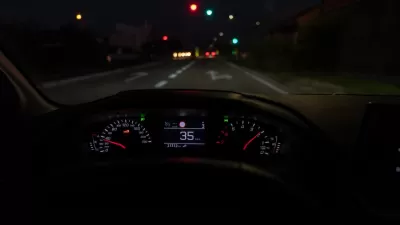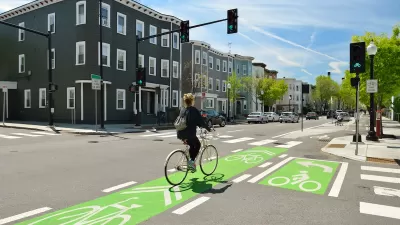The design of intersections between major roadways and bike and pedestrian paths can have fatal consequences.

Using an example from a New Jersey segment of the East Coast Greenway, the nation’s longest biking and walking route, Asia Mieleszko highlights the danger raised by the intersection of greenways with highways and major arterial roads.
“While its most beloved segments are secluded and separated from motorized traffic, as much as 65% of the ECG involves interacting with cars and trucks that are moving at high speeds.” This puts the people biking and walking on the trail at risk, and has in some cases resulted in fatal crashes. In many places, the crossings are denoted only by a painted crosswalk, and drivers routinely ignore speed limits.
One problem, Mieleszko points out, is that the standards that county roads are held to often don’t match up with local realities. “ Often, they’re thought of as connectors between distant places, a means of getting from one side of town to the other, from one city to another dozens of miles away. As such, they prioritize the speed and throughput of vehicles in order to make that ride from A to B as efficient and seamless as possible.”
In practice, many of the country’s most dangerous, fast-moving roads intersect with pathways for people walking and biking. It takes consistent effort from local advocates to get state and county agencies to make changes that could, in theory, contradict their mandate to maintain fast traffic throughput.
FULL STORY: A Disaster Waiting to Happen: Where Our Greenways Meet Our Highways

Alabama: Trump Terminates Settlements for Black Communities Harmed By Raw Sewage
Trump deemed the landmark civil rights agreement “illegal DEI and environmental justice policy.”

Planetizen Federal Action Tracker
A weekly monitor of how Trump’s orders and actions are impacting planners and planning in America.

The 120 Year Old Tiny Home Villages That Sheltered San Francisco’s Earthquake Refugees
More than a century ago, San Francisco mobilized to house thousands of residents displaced by the 1906 earthquake. Could their strategy offer a model for the present?

In Both Crashes and Crime, Public Transportation is Far Safer than Driving
Contrary to popular assumptions, public transportation has far lower crash and crime rates than automobile travel. For safer communities, improve and encourage transit travel.

Report: Zoning Reforms Should Complement Nashville’s Ambitious Transit Plan
Without reform, restrictive zoning codes will limit the impact of the city’s planned transit expansion and could exclude some of the residents who depend on transit the most.

Judge Orders Release of Frozen IRA, IIJA Funding
The decision is a victory for environmental groups who charged that freezing funds for critical infrastructure and disaster response programs caused “real and irreparable harm” to communities.
Urban Design for Planners 1: Software Tools
This six-course series explores essential urban design concepts using open source software and equips planners with the tools they need to participate fully in the urban design process.
Planning for Universal Design
Learn the tools for implementing Universal Design in planning regulations.
Clanton & Associates, Inc.
Jessamine County Fiscal Court
Institute for Housing and Urban Development Studies (IHS)
City of Grandview
Harvard GSD Executive Education
Toledo-Lucas County Plan Commissions
Salt Lake City
NYU Wagner Graduate School of Public Service





























